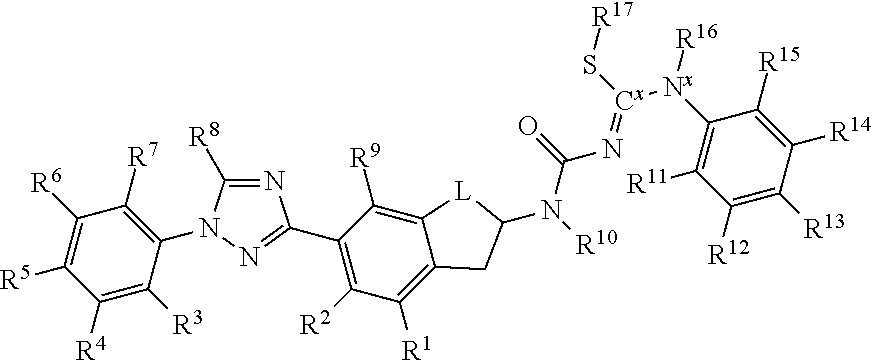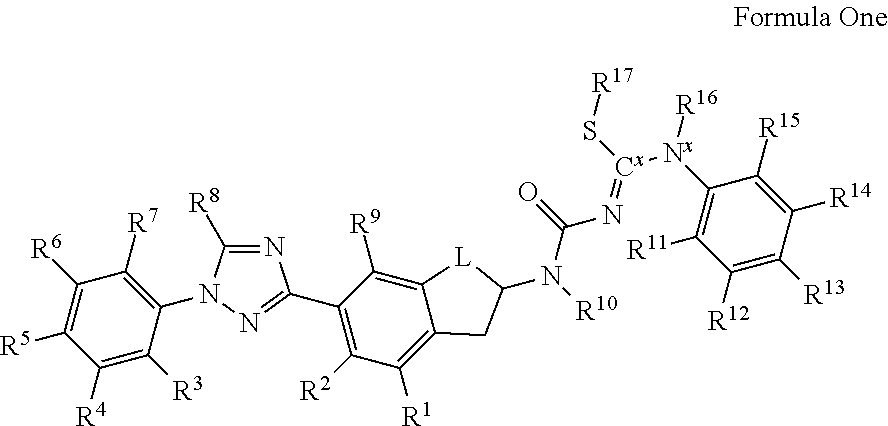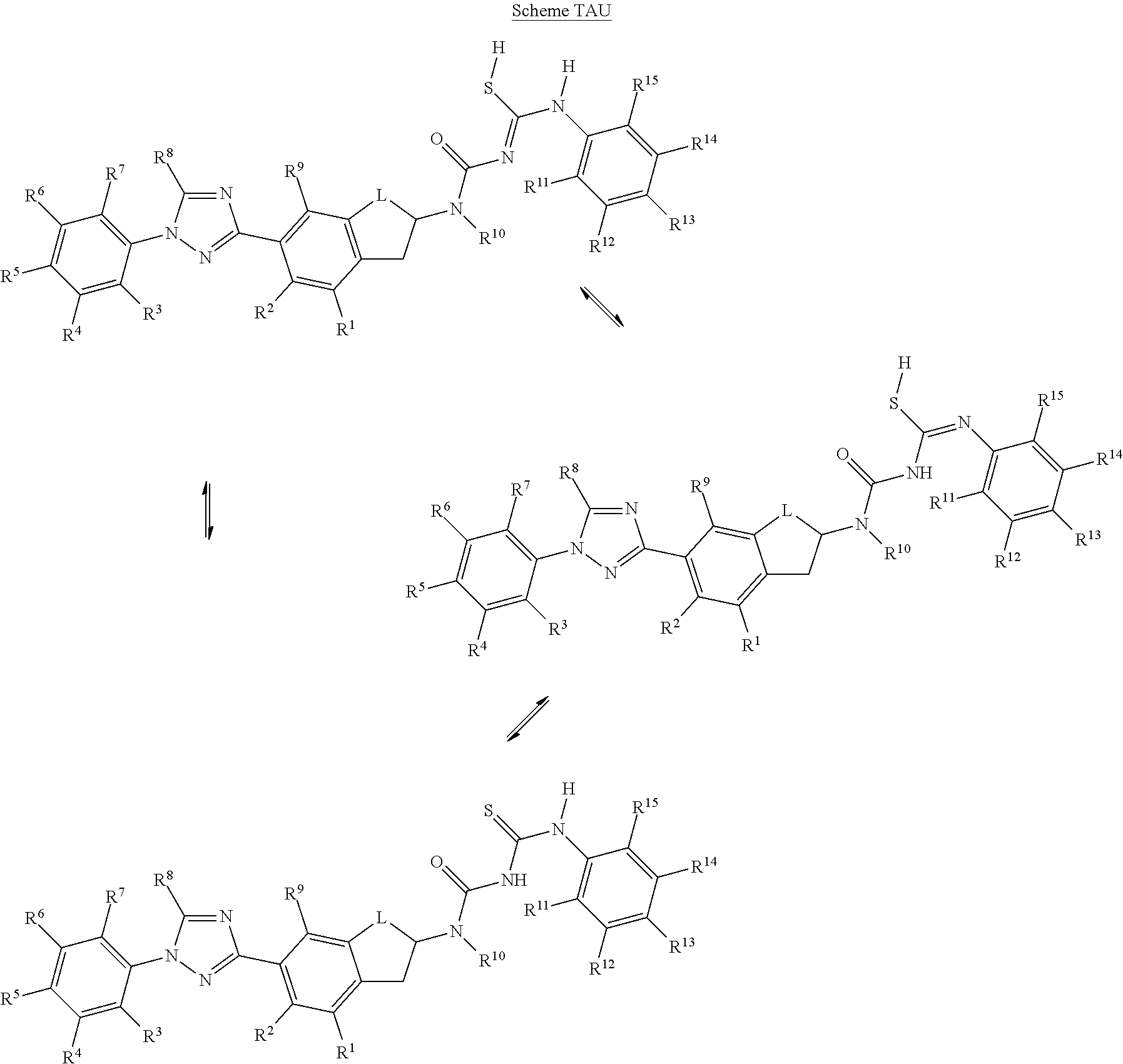Molecules having certain pesticidal utilities, and intermediates, compositions, and processes related thereto
a technology of pesticidal utilities and molecules, applied in the field of processes to produce molecules, can solve the problems of millions of human deaths around the world, loss of agriculture, damage to all kinds of private and public structures,
- Summary
- Abstract
- Description
- Claims
- Application Information
AI Technical Summary
Benefits of technology
Problems solved by technology
Method used
Image
Examples
example 1
Preparation of tert-butyl (5-(1-(4-(trifluoromethoxy)phenyl)-1H-1,2,4-triazol-3-yl)-2,3-dihydro-1H-inden-2-yl)carbamate (C1)
[0081]
[0082]To 3-bromo-1-(4-(trifluoromethoxy)phenyl)-1H-1,2,4-triazole (2.75 g, 8.93 mmol), tert-butyl (5-(4,4,5,5-tetramethyl-1,3,2-dioxaborolan-2-yl)-2,3-dihydro-1H-inden-2-yl)carbamate (3.21 g, 8.93 mmol), sodium bicarbonate (1.50 g, 17.9 mmol), dioxane (45 mL) and water (15 mL) in a round-bottomed flask (100 mL) equipped with a stir bar and nitrogen was added tetrakis(triphenylphosphine)palladium(0) (1.03 g, 0.893 mmol). The reaction vessel was evacuated with vacuum and purged with nitrogen (2×). The reaction was heated to 80° C. overnight. The reaction was cooled, diluted with ethyl acetate and washed with water. The aqueous layer was extracted with ethyl acetate. The combined organic layers were washed with Brine, dried over sodium sulfate, filtered, and concentrated. Purification by flash column chromatography using 0-40% ethyl acetate / B, where B=1:1 di...
example 2
Preparation of tert-butyl (5-(1-(4-(perfluoroethoxy)phenyl)-1H-1,2,4-triazol-3-yl)-2,3-dihydro-1H-inden-2-yl)carbamate (C2)
[0083]
[0084]3-Bromo-1-(4-(perfluoroethoxy)phenyl)-1H-1,2,4-triazole (0.409 g, 1.14 mmol), tert-butyl (5-(4,4,5,5-tetramethyl-1,3,2-dioxaborolan-2-yl)-2,3-dihydro-1H-inden-2-yl)carbamate (0.411 g, 1.14 mmol), sodium bicarbonate (0.0960 g, 1.14 mmol), tetrakis(triphenylphosphine)palladium(0) (0.132 g, 0.114 mmol), dioxane (6 mL), and water (2 mL) in a vial (20 mL) were capped and heated at 140° C. for 30 minutes in a Biotage Initiator® microwave reactor with external IR-sensor temperature monitoring from the side of the vessel. The reaction was diluted with ethyl acetate and washed with water. The aqueous layer was extracted with ethyl acetate. The combined organic layers were washed with Brine. The organic layers were dried over sodium sulfate, filtered, and concentrated. Purification by flash column chromatography using 0-20% ethyl acetate / B, where B=1:1 dichlor...
example 3
Preparation of 5-(1-(4-(trifluoromethoxy)phenyl)-1H-1,2,4-triazol-3-yl)-2,3-dihydro-1H-inden-2-amine dihydrochloride (C3)
[0085]
[0086]To tert-butyl (5-(1-(4-(trifluoromethoxy)phenyl)-1H-1,2,4-triazol-3-yl)-2,3-dihydro-1H-inden-2-yl)carbamate (C1) (0.484 g, 1.05 mmol) in a round-bottomed flask (100 mL) equipped with a stir bar and nitrogen was added dioxane (3 mL) and hydrogen chloride (4 M in dioxane, 3.02 mL, 12.1 mmol). The reaction was stirred overnight at room temperature. Additional hydrogen chloride (4 M in dioxane, 3.02 mL, 12.1 mmol) was added and the reaction was heated to 40° C. overnight. More hydrogen chloride (4 M in dioxane, 3.02 mL, 12.1 mmol) was added. After several hours, the reaction was cooled to room temperature and diluted with diethyl ether. The solid was filtered, washed with diethyl ether, and dried under house vacuum providing the title compound as a white solid (0.379 g, 83%): 1H NMR (400 MHz, DMSO-d6) δ 9.41 (s, 1H), 8.36-8.17 (m, 3H), 8.11-8.04 (m, 2H), 8...
PUM
| Property | Measurement | Unit |
|---|---|---|
| molecular mass | aaaaa | aaaaa |
| temperatures | aaaaa | aaaaa |
| temperatures | aaaaa | aaaaa |
Abstract
Description
Claims
Application Information
 Login to View More
Login to View More - R&D
- Intellectual Property
- Life Sciences
- Materials
- Tech Scout
- Unparalleled Data Quality
- Higher Quality Content
- 60% Fewer Hallucinations
Browse by: Latest US Patents, China's latest patents, Technical Efficacy Thesaurus, Application Domain, Technology Topic, Popular Technical Reports.
© 2025 PatSnap. All rights reserved.Legal|Privacy policy|Modern Slavery Act Transparency Statement|Sitemap|About US| Contact US: help@patsnap.com



